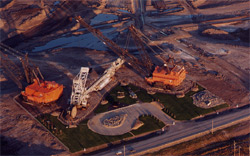| Fort
McMurray’s oil sands industry is a prosperous one and as it
continues to grow, it promises success well into the new
millennium. |
 |
The technologies and
processes of oil sands mining are fairly young compared to their
counterparts in the conventional oil industry. Nevertheless,
the history of Fort McMurray’s oil sands is rich with the
experiences, setbacks and successes of the people who came to
this region in hopes of developing this valuable resource. |
| Aboriginal
people had long since known about the bitumen produced by the
oil sand and even used it to waterproof their canoes. However,
it was not until 1778 that fur trader Peter Pond first
documented Oil Sands and bitumen pools in his journal. |
 |
Among the first explorers
are Count Alfred von Hammerstein, a former member of the
Prussian army office corps, and “Peace River Jim”
Cornwall. From 1906 to 1910, both drilled wells in hopes
of striking a pool of oil, which they believed to be
underneath a layer of sand. Although their attempts were
unsuccessful, they did bring the necessary attention to
the Athabasca oil sands that helped pave the way to a
successful enterprise.
In 1913, Sidney Ells was sent to the
area by the Federal Department of Mines and spent the
next 32 years detailing a complete map of the sands and
experimenting with separation theories.
|
|
|
| Karl J. Clark, a chemical engineer
who had been researching the sands for oil extraction and road
paving, was sent to the region in 1920. In 1924 and 1925,
working closely with the University of Alberta and Sidney M.
Blair, Clark built a separation plant in Edmonton that employed
the hot water method of separating sand from oil. This process
would form the basis of today’s extraction technology.
In 1929 Robert Fitzsimmons opened a small pit
and hot water separation plant at Bitumount approximately 70 Km
north of Fort McMurray. After some time, partly due to the
American Canal Project, the Bitumount plant closed. In 1948, the
government reopened the plant to make a commercial-volume test
of Clark’s hot water process.
|
 |
| Max Bell, an oilman
from Denver, opened a separation plant in Abasand that operated
from 1936 to 1941, when a fire damaged the powerhouse. It was
rebuilt in 1943 and permanently destroyed in 1945 when a second
fire ignited. |
 |
In 1967 Great Canadian
Oil Sands, now Suncor Energy, proved that bitumen could be
successfully removed form oil sand and upgraded to crude oil on
a large scale. Syncrude Canada Ltd. followed in 1978 and the
industry never looked back. A number of other companies, anxious
to stake claims on the future are forging ahead with plans for
development and expansion.
Oil sands technology continues to develop as
more efficient processes are discovered. Among the new processes
that will greatly impact the future of the Oilsands are hydro-transport and
SAG-D (Steam Assisted Gravity Drainage).
|
| The hydro-transport system is
replacing the costly conveyor belt system to move oil sand from
the pit mine to the extraction plant while concurrently
preparing it for upstream processing by mixing it with hot
water. Perhaps the most promising of in-situ methods is SAG-D, a technique that involves
drilling wells into the oil sand and injecting steam to separate
the water and bitumen from the sand. The slurry mixture is
then brought to the surface using vacuum-like pressure.
The dreams of those early visionaries are now
reality, and if history is any indication, the best is yet to
come.
return to
Fort McMurray page
Oil Sands picture page
|
|



